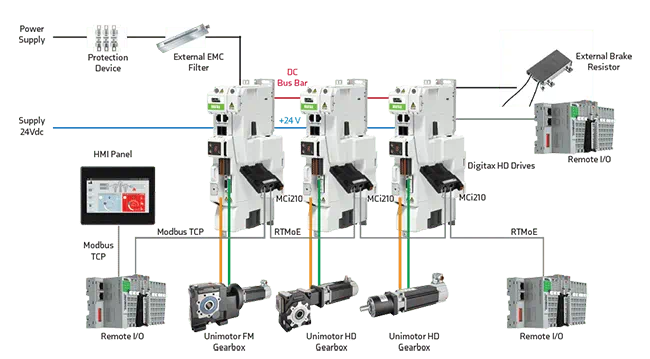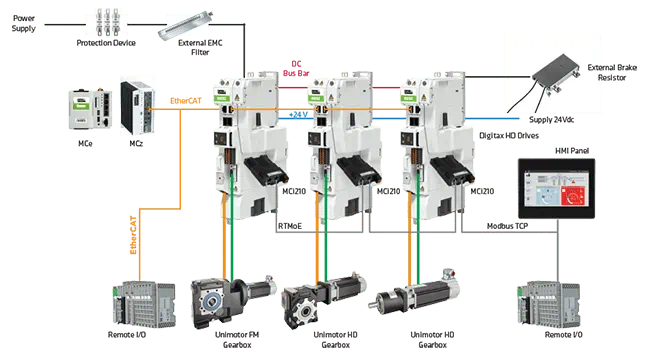
- Overview
- Downloads
Industrial control applications typically use a PLC system to manage the process; using I/O to provide an interface to switches, relays and sensors attached to the machine.
To supplement this controller platform and dramatically extend the range of applications that can benefit from this cost- and performance-optimised solution, we now have an extensive range of remote I/O.
Benefits of Control Techniques RTMoE remote I/O:
- Allows the number of I/O points to be dramatically expanded over those available on the drive
- Brings greater diversity to the type of I/O points available
- Remote I/O is directly supported by any Ethernet based Unidrive, through the optional SI-Ethernet module or the Ethernet port on board of the MCi210
- Combining with an MCi210 module gives a versatile and powerful controller platform
For applications where an industrial PLC is required, Control Techniques is able to provide an EtherCAT Remote I/O.
RTMoE or Modbus TCP Remote I/Os
In this configuration, add-on RTMoE / Modbus TCP Remote I/O modules connect directly via the on-board Ethernet port of the Unidrive M7XX series drives, through the optional SI-Ethernet module or via the on-board Ethernet port of the MCi210 Machine Control option modules.
A typical configuration (as shown below) would include MCi2XX Machine Control option modules, Machine Control Studio software and the MCh040/MCh070 HMI Panels. All sensor inputs can be monitored, and outputs controlled, including LEDs, pushbuttons, temperature controls, machine status indicators and fluid flow sensors.

EtherCAT Remote I/Os
In this configuration, add-on EtherCAT Remote I/O modules connect via the on-board EtherCAT port of the MCe or MCz controllers, or through any EtherCAT port on any PLC or controller.
A typical scalable configuration (as shown below) would feature the EtherCAT Remote I/O module, used together with MCe or MCz controllers, MCi2XX Machine Control option modules, Machine Control Studio software and the MCh040/MCh070 HMI Panels. All sensor inputs can be monitored, and outputs controlled, including LEDs, pushbuttons, temperature controls, machine status indicators and fluid flow sensors.


